Science
(www.olympiadsuccess.com)
Chapter 6: Combustion and Flame
Class: VIII
Exemplar Solutions
MULTIPLE CHOICE QUESTIONS
Question 1
A substance which reacts with oxygen giving heat is called a combustible substance. Which, one of the following is a combustible substance?
(a) iron nail (c) stone piece
(b) glass (d) wood
Answer 1 (d)
Question 2
Which one of the following has the highest calorific value?
(a) kerosene (c) LPG
(b) biogas (d) petrol
Answer 2 (c)
Question 3
Magnesium ribbon on burning in air produces
(a) magnesium oxide, water and light
(b) magnesium oxide and heat
(c) magnesium oxide, heat and light
(d) magnesium oxide, water and heat
Answer 3 (c)
Question 4
Which of the following is not a combustible substance?
(a) camphor (c) straw
(b) glass (d) alcohol
Answer 4 (b)
Question 5
The substance that does not burn with flame is
(a) LPG (c) dry gas
(b) camphor (d) charcoal
Answer 5 (d)
Question 6
On placing an inverted tumbler over a burning candle, the flame extinguishes after some time. This is because of nonavailability of
(a) Oxygen (c) carbon dioxide
(b) water vapours (d) wax
Answer 6 (a)
Question 7
If a person’s clothes catches fire, the best way to extinguish the fire is to:
(a) throw water on the clothes.
(b) use fire extinguisher.
(c) cover the person with a woolen blanket.
(d) cover the person with a polythene sheet.
Answer 7 (c)
Question 8
The substance expected to have the highest ignition temperature out of the following is
(a) kerosene (c) coal
(b) petrol (d) alcohol
Answer 8 (c)
Question 9
Choose the correct statement about inflammable substances from the following.
They have:
(a) low ignition temperature and cannot catch fire easily.
(b) high ignition temperature and can catch fire easily.
(c) low ignition temperature and can catch fire easily.
(d) high ignition temperature and cannot catch fire easily.
Answer 9 (c)
Question 10
Choose the incorrect statement from the following. Forest fires are usually due to:
(a) carelessness of humans (c) cutting of trees
(b) heat of sun (d) lightning strike
Answer 10 (c)
Question 11
The calorific value of a fuel is expressed in a unit called
(a) kilojoule per litre (c) kilojoule per gram
(b) kilogram per mililitre (d) kilojoule per kilogram
Answer 11 (d)
Question 12
In villages, people use wood as fuel because:
(a) it is considered to be an ideal fuel.
(b) of its easy availability and low cost.
(c) it is environment friendly.
(d) it catches fire easily.
Answer 12 (b)
Question 13
Which among the following is considered as the cleanest fuel?
Answer 13 (d)
Question 14
Choose the incorrect statement from the following.
A good fuel is one which:
(a) is readily available.
(b) produces a large amount of heat.
(c) leaves behind many undesirable substances.
(d) burns easily in air at a moderate rate.
Answer 14 (c)
Question 15
Shyam was cooking potato curry on a chulha. To his surprise he observed that the copper vessel was getting blackened from outside. It may be due to:
(a) proper combustion of fuel.
(b) improper cooking of potato curry.
(c) improper combustion of the fuel.
(d) burning of copper vessel.
Answer 15 (c)
Question 16
Fill in the blanks in the following sentences.
(a) A ____________ process in which a substance reacts with __________ to give off heat is called combustion.
(b) When the clothes of a person catch __________, the person is covered with a __________ to extinguish fire.
(c) The __________ temperature at which a substance catches fire is called its __________ temperature.
(d) The substances which have very ________________ ignition temperature and can easily catch fire with a flame are called __________ substances.
(e) The substances which vapourise during __________, give flame.
Answer 16
(a) Chemical, oxygen; (b) fire, blanket (c) lowest, ignition; (d) low, inflammable (e) burning.
Question 17
Some words (underlined) in the following sentences are jumbled up. Write them in their correct form.
(a) Seldie is a combustible substance.
(b) Slags is a non-combustible material.
(c) Chittsmack does not burn by itself.
(d) Some substances on combustion produce thea and mafel.
(e) The amount of heat energy produced on complete combustion of 1 kg of a fuel is called its ficalroic value.
Answer 17
(a) diesel; (b) glass; (c) matchstick; (d) heat, flame; (e) calorific
Question 18
Two glass jars A and B are filled with carbon dioxide and oxygen gases, respectively. In each jar a lighted candle is placed simultaneously. In which jar will the candle remain lighted for a longer time and why?
Answer 18
In jar B, because oxygen is a supporter of combustion.
Question 19
Anu wants to boil water quickly in a test tube. On observing the different zones of the flame, she is not able to decide which zone of the flame will be best for boiling water quickly. Help her in this activity.
Answer 19
Anu should keep her test tube in the outermost zone which is the hottest part of the flame.
Question 20
Why is the use of diesel and petrol as fuels in automobiles being replaced by Compressed Natural Gas (CNG) in big cities?
Answer 20
It is becuase CNG produces harmful products in very small amount and is a cleaner fuel.
Short Answer Questions
Question 21
Boojho wants to separate the following materials as combustible and non-combustible. Can you help him?
Charcoal, chalk, stone, iron rod, copper coin, straw,
cardboard, glass, paper, candle, wood.
Answer 21
(a) Combustible — charcoal, straw, card board, paper, candle wood,
(b) Non-combustible — chalk, stone, iron rod, copper coin, glass.
Question 22
Indicate whether the following statements are True or False. Also write the false statements in their correct form.
(a) Air is necessary for combustion.
(b) Magnesium is a non-combustible metal.
(c) Carbon dioxide is an excellent fire extinguisher.
(d) Calorific value of wood is higher than that of coal.
Answer 22
(a), (c) are true statements.
(b) Magnesium is a combustible metal
(d) Calorific value of coal is higher than that of wood.
Question 23
Match the items of Column A with the items of Column B.
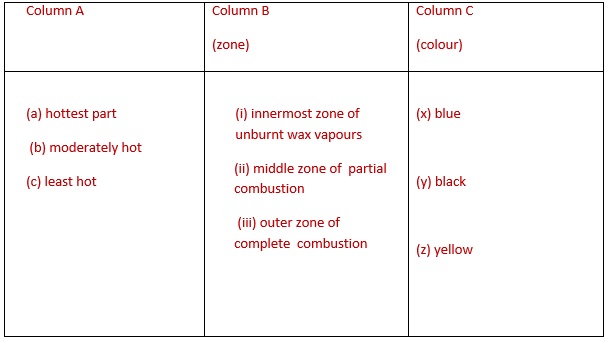
Answer 23
Question 24
Match the following for the flame of a candle.
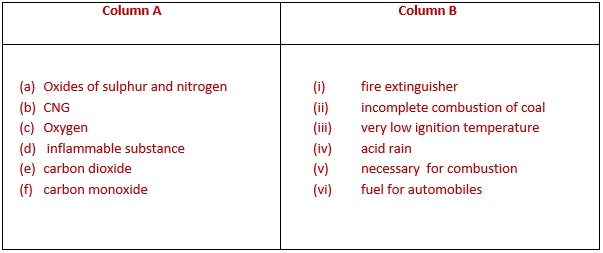
Answer 24
Question 25
If you hold a piece of iron wire with a pair of tongs inside a candle flame or a Bunsen burner flame, what will you observe? Will it produce a flame?
Answer 25
Iron wire will become red hot and glow. It will not produce a flame.
Question 26
Fill in the blanks using the words given in the box.
ignition, petrol, combustion, calorific value,
combustible, inflammable
(a) A chemical process in which a substance reacts with oxygen to give off heat is called __________.
(b) Wood, paper, CNG are __________ substances.
(c) The lowest temperature at which a substance catches fire is called its __________ temperature.
(d) Ignition temperature of __________ is lower than that of wood.
(e) The substances which have very low __________ temperature and can easily catch fire with a flame are called __________ substances.
(f) The amount of heat energy produced on complete combustion of 1kg of a fuel is called its __________.
Answer 26
(a) combustion, (b) combustible, (c) ignition, (d) petrol, (e) ignition, inflammable, (f) calorific value.
Question 27
People usually keep Angethi/burning coal in their closed rooms during winter season. Why is it advised to keep the door open?
Answer 27
Due to insufficient availability of oxygen in the closed room carbon monoxide gas is produced which can kill persons sleeping in that room.
Question 28
Write True/False against the following statements and also correct the false statement.
(a) A physical process in which a substance reacts with oxygen to give off heat is called combustion.
(b) Water is the best extinguisher for fires involving electrical equipment.
(c) Alcohol, CNG and LPG are inflammable substances.
(d) Increased concentration of nitrogen in air is believed to cause global warming.
(e) Greater the calorific value, better is the fuel.
(f) Middle zone is the hottest zone of a flame.
(g) The substances which vapourise during burning, give flame.
Answer 28
(a) False – A chemical process in which a substance reacts with oxygen to give off heat is called combustion.
(b) False – Carbon dioxide is the best extinguisher for fires involving electrical equipment.
(c) True.
(d) False – Increased concentration of carbon dioxide in air is believed to cause global warming
(e) True.
(f) False – outer zone is the hottest zone of a flame.
(g) True.
Question 29
Cracker on ignition produces sound. Why?
Answer 29
Hint: Sudden formation of large amount of gas due to chemical reactions.
Question 30
What do you understand by fuel efficiency?
Answer 30
Hint: calorific value.
Question 31
You are provided with three watch glasses containing milk, petrol and mustard oil, respectively. Suppose you bring a burning candle near these materials one by one, which material(s) will catch fire instantly and why?
Answer 31
Hint: Pertrol will catch fire instantly because it is highly inflammable.
Question 32
Manu was heating oil to fry potato chips. The cooking oil all of a sudden caught fire; he poured water to extinguish the fire. Do you think this action was suitable. If yes, why? If not, why not? In such a condition what should Manu have done?
Answer 32
Hint:
Question 33
What are the three essential requirements to produce fire? How fire extinguisher is useful for controlling the fire.
Answer 33
Hint: Three essential requirements.
The job of fire extinguisher is to cut off the supply of air or to bring down the temperature of fuel or both.
Question 34
Give two examples each for a solid, liquid and gaseous fuel alongwith some important uses.
Answer 34
Hint: Types of fuels
Solid fuel – Coal, wood, etc.
Liquid fuel – Kerosene oil, petrol etc.
Gaseous fuel – CNG, LPG etc.
Uses
Coal – cooking etc.
Kerosene oil – Fuel for stoves, lamps etc.
LPG – Fuel for industry etc.
Add more uses.
Question 35.
The calorific values of petrol and CNG are 45000 kJ/kg and 50,000 kJ/kg, respectively. If you have vehicle which can run on petrol as well as CNG, which fuel will you prefer and why?
Answer 35
Hint: CNG, because the calorific value of CNG is higher than that of petrol. Therefore CNG will be more economical. At the same time it produces the least air pollutants.
Question 36
Although wood has a very high calorific value, we still discourage its use as a fuel. Explain.
Answer 36
Hint:
(ii) Use of wood as fuel encourages cutting of trees leading to deforestation.
Question 37
Forest fire produces a lot of air pollution. Write in brief about the reasons of forest fires.
Answer 37
Hint:
Question 38
Complete the crossword Fig. 6.1 with the help of the clues:
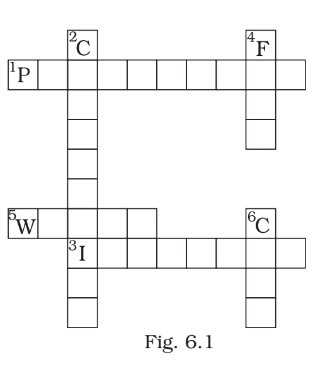
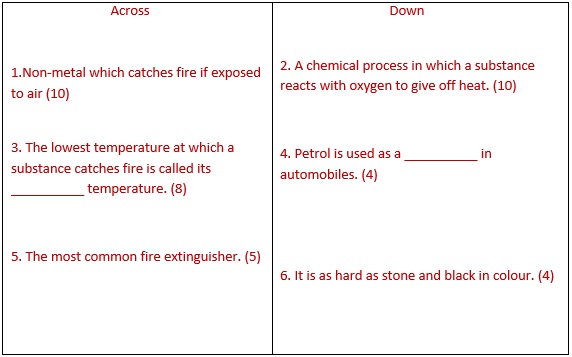
Answer 38
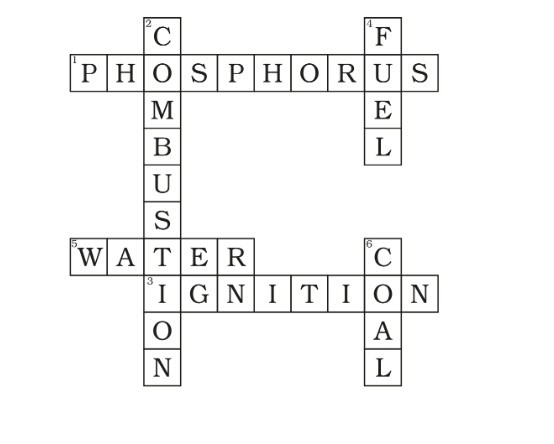
Yearlong program for Olympiads preparation & to build necessary skills for future.
Explore More
Time to mark your calendar with the upcoming Olympiads exam schedule.
Explore More
Take your Olympiad preparation to next-level by taking LIVE Classes.
Explore More
Assess your performance by taking topic-wise and full length mock tests.
Explore More
Online tuitions for international compeitions like SASMO, SEAMO, etc for Grades 1-11.
Explore More